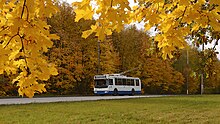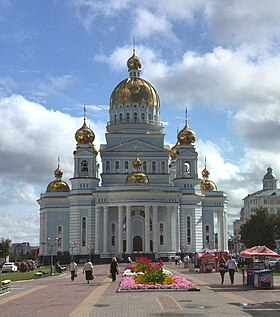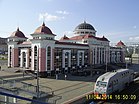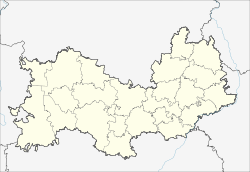LIMSwiki
Contents
Saransk
Саранск | |
|---|---|
| Other transcription(s) | |
| • Moksha | Саранск ошсь |
| • Erzya | Саран |
|
Clockwise from top: Cathedral of St. Theodore Ushakov, Regional museum, Saransk I railway station, Opera and Ballet Theatre of Saransk, Millennium square and main building Mordovian State University | |
| Coordinates: 54°11′N 45°11′E / 54.183°N 45.183°E | |
| Country | Russia |
| Federal subject | Mordovia[1] |
| Founded | 1641[2] |
| City status since | 1780[3] |
| Government | |
| • Body | Council of Deputies |
| • Mayor[4] | Pyotr Tultayev[4] |
| Area | |
• Total | 383 km2 (148 sq mi) |
| Elevation | 160 m (520 ft) |
| Population | |
• Total | 297,415 |
• Estimate (2018)[7] | 318,841 (+7.2%) |
| • Rank | 64th in 2010 |
| • Density | 780/km2 (2,000/sq mi) |
| • Subordinated to | city of republic significance of Saransk[1] |
| • Capital of | Republic of Mordovia[8] |
| • Capital of | city of republic significance of Saransk[1] |
| • Urban okrug | Saransk Urban Okrug[9] |
| • Capital of | Saransk Urban Okrug[9] |
| Time zone | UTC+3 (MSK |
| Postal code(s)[11] | 430000–430013, 430015–430019, 430021, 430023–430025, 430027, 430028, 430030–430034, 430700, 430899, 430950, 995300 |
| Dialing code(s) | +7 8342[12] |
| OKTMO ID | 89701000001 |
| City Day | June 12 |
| Website | www |
Saransk (UK: /səˈrænsk/, US: /sɑːˈrɑːnsk/)[a] is the capital city of Mordovia, Russia, as well as its financial and economic centre. It is located in the Volga basin at the confluence of the Saranka and Insar Rivers, about 630 kilometers (390 mi) east of Moscow. Saransk was one of the host cities of the official tournament of the 2018 FIFA World Cup.
History

The Russian fortress Atemar, founded in 1641,[2] took its name from a nearby Mordvin village; at the time the fortress stood on the southeastern frontier of the Tsardom of Russia. The current name, "Saransk", refers to the city's situation on the Saranka river. Soon after its founding, the city became an important trade centre for nearby Erzya villagers. After 1708 Saransk was assigned to Azov Province, and later to the Kazan Governorate. In 1780 the settlement was granted town status and was again transferred, this time to the Penza Governorate, which was previously called the Penza Namestnichestvo, but was renamed to Penza Governorate by Paul I in 1796. On 11 October 1797, the Penza Governorate was divided into several governorates, one of which was the Simbirsk Governorate, which was composed of the Saransk and Insar uezds. By the ukaz of Alexander I, the Penza Governorate was re-established and now was divided into 10 uezds.[13]
In 1928 Saransk was the administrative centre of the newly established Mordvin National Okrug, which became the Mordovian Autonomous Oblast in 1930. In 1941 Saransk was near the front line in the Battle of Moscow, but was never reached by the Wehrmacht. Soviet planners reconstructed the old city centre in the 1960s and 1970s, adding wide streets and planning the construction of massive residential areas.
Administrative and municipal status
Saransk is the capital of the Mordovian republic.[8] Within the framework of administrative divisions, it is, together with three work settlements (Lukhovka, Nikolayevka, and Yalga) and thirteen rural localities, incorporated as the city of republic significance of Saransk—an administrative unit with the status equal to that of the districts.[1] As a municipal division, the city of republic significance of Saransk is incorporated as Saransk Urban Okrug.[9]
Geography
The city is located in the Volga basin at the confluence of the Saranka and Insar Rivers, about 630 kilometers (390 mi) east of Moscow.
Climate
Saransk has a relatively chilly version of the humid continental climate (Köppen: Dfb)[14] with warm but not hot summers and cold winters, that averages well below freezing for five months of the year. Transition periods are extremely short and only April and October are between 0 °C (32 °F) and 10 °C (50 °F) in mean temperatures.
| Climate data for Saransk | |||||||||||||
|---|---|---|---|---|---|---|---|---|---|---|---|---|---|
| Month | Jan | Feb | Mar | Apr | May | Jun | Jul | Aug | Sep | Oct | Nov | Dec | Year |
| Record high °C (°F) | 4.8 (40.6) |
14.0 (57.2) |
16.3 (61.3) |
28.9 (84.0) |
34.0 (93.2) |
36.1 (97.0) |
38.0 (100.4) |
39.4 (102.9) |
32.3 (90.1) |
23.0 (73.4) |
13.9 (57.0) |
7.1 (44.8) |
39.4 (102.9) |
| Mean daily maximum °C (°F) | −6.7 (19.9) |
−4.9 (23.2) |
0.4 (32.7) |
11.7 (53.1) |
21.4 (70.5) |
23.6 (74.5) |
25.9 (78.6) |
24.7 (76.5) |
17.8 (64.0) |
9.3 (48.7) |
1.0 (33.8) |
−3.5 (25.7) |
10.0 (50.0) |
| Daily mean °C (°F) | −9.6 (14.7) |
−8.2 (17.2) |
−3.4 (25.9) |
6.1 (43.0) |
15.0 (59.0) |
17.7 (63.9) |
19.9 (67.8) |
18.4 (65.1) |
12.4 (54.3) |
5.4 (41.7) |
−1.7 (28.9) |
−5.9 (21.4) |
5.5 (41.9) |
| Mean daily minimum °C (°F) | −12.4 (9.7) |
−11.2 (11.8) |
−6.8 (19.8) |
1.4 (34.5) |
9.1 (48.4) |
12.0 (53.6) |
14.2 (57.6) |
13.0 (55.4) |
7.9 (46.2) |
2.4 (36.3) |
−4.0 (24.8) |
−8.3 (17.1) |
1.5 (34.7) |
| Record low °C (°F) | −44.0 (−47.2) |
−39.7 (−39.5) |
−31.5 (−24.7) |
−17.6 (0.3) |
−6.0 (21.2) |
−2.4 (27.7) |
4.9 (40.8) |
0.0 (32.0) |
−5.0 (23.0) |
−14.6 (5.7) |
−29.5 (−21.1) |
−36.0 (−32.8) |
−44.0 (−47.2) |
| Average precipitation mm (inches) | 34 (1.3) |
29 (1.1) |
27 (1.1) |
36 (1.4) |
34 (1.3) |
47 (1.9) |
52 (2.0) |
57 (2.2) |
42 (1.7) |
42 (1.7) |
30 (1.2) |
40 (1.6) |
471 (18.5) |
| Average precipitation days (≥ 0.1 mm) | 15.0 | 12.2 | 13.0 | 11.3 | 12.8 | 16.5 | 15.7 | 13.5 | 11.9 | 12.7 | 12.7 | 14.9 | 162.2 |
| Source: [15] | |||||||||||||
Industry
Industrial activity in Saransk includes the production of electrical cables, chemical production, textile manufacturing, food processing, machine building, and metallurgy. The city has two thermal power stations. The city has the confectionery plant Lamzur.
The most notable industrial enterprises include the Lisma Electrical Factory which employs nearly 12,000 people; the Biokhimik pharmaceutical facility; Rezinotekhnika, a rubber products manufacturer; cable manufacturer Saranskkabel; and Elektrovypryamitel, which manufactures electronic components and, on a small scale, television sets.
Demographics
| Year | Pop. | ±% |
|---|---|---|
| 1897 | 15,000 | — |
| 1926 | 15,000 | +0.0% |
| 1939 | 41,146 | +174.3% |
| 1959 | 91,034 | +121.2% |
| 1970 | 190,575 | +109.3% |
| 1979 | 263,337 | +38.2% |
| 1989 | 312,128 | +18.5% |
| 2002 | 304,866 | −2.3% |
| 2010 | 297,415 | −2.4% |
| 2021 | 314,871 | +5.9% |
| Source: Census data | ||
Saransk is by far the largest city in Mordovia and accounts for 34.3% of the total population of the republic (as of the 2002 Census). Ethnic Russians form the majority of the population (about 85%), and Russian, rather than any of the two co-official Mordvinic languages, is the common language of communication in the city. As with many provincial capitals in Russia, the population of Saransk decreased after the dissolution of the Soviet Union, primarily as a result of economic migration to larger cities, made especially attractive by the downsizing, or outright collapse, of many smaller, regional, industrial enterprises. The population started to grow again in 2009. Population: 297,415 (2010 Census);[6] 304,866 (2002 Census);[16] 312,128 (1989 Soviet census).[17]
Culture and religion
The Saransk Regional Museum is dedicated primarily to the history of the city, while the Mordovian Museum of Visual Arts has a collection of works by the Russian masters Stepan Erzia and Fedot Sychkov.
The city is home to the Mordovian State University (founded in 1957) as well as several technical colleges.
Saransk has three Orthodox churches and also a small Lutheran church (Finnish Lutheran Church), which was opened in 2005. There are also three mosques. The main cathedral in Saransk is the Cathedral of St. Theodore Ushakov, the construction of which was completed in 2006.

Mordovia Yaushev State Music Theater in Saransk, the capital of Mordovia. It was founded in 1932 by Moscow Academy of Maly Theatre . Initially the theatre performed Russian classics, translated into the Mordovian languages, but later they began to adapt the drama works of national authors for the stage.
Saransk has several theatres, including:
- The State Russian Drama Theatre, opened on 25 August 1932 and initially called the Mordovian National Theatre
- The Opera and Ballet Theater, opened on 9 September 2011
- The State Puppet Theater of the Republic of Mordovia
- The Mordovia National Drama Theatre, opened in 1932 by the Moscow Academy of Maly Theatre
Sport

Saransk is a major sports center of the Volga region. The city has several large sports facilities, such as the Republican Palace of Sports, Ice Palace, Mordovia Sports Complex, Leonid Arkaev Gymnastics Center, various sports and fitness clubs and gyms. The city territory accommodates two large stadiums: Start and Mordovia Arena.
Mordovia has extensive experience as a host to federal and international sporting events. In 2012, Saransk hosted the IAAF World Race Walking Cup, while the city's FC Mordovia Saransk played three seasons in the Russian Premier League against the country's leading football clubs.
In 2016, Mordovia was named the most athletic region in the country. The number of locals engaged in regular sports activities is growing and is as of today at 36%. There are over 2100 sports facilities in Saransk. Those include:
- Mordovia Arena stadium. A stadium that hosted the group matches of the 2018 FIFA World Cup
- Athletics Sports School for Olympic Reserve
- Mordovia Sports Complex
- Ice Palace of the Republic of Mordovia
- Palace of Sports
- Olimp Sports Complex
- Formula S Sports and Entertainment Complex
- Mordovia Tennis Center
- Skiing and Biathlon Complex of the Republic of Mordovia
- Start Stadium
- Palace of Water Sports
- Saransk Stadium
From 16 to 28 June 2018, Saransk hosted the 2018 FIFA World Cup. Mordovia Arena hosted four group stage matches.[18]
Cityscape and architecture
The city has a large number of buildings remaining from the 17th and 18th centuries; however, many parts of the town are dominated by Soviet era apartment blocks, dating mainly from the 1960s, similar to other provincial towns which expanded rapidly due to fast industrialization. These buildings are nearing the end of their service life and are in need of serious repair and, in many cases, replacement. Industrial enterprises are mainly located to the north of the town center. The eastern part of Saransk, located east of the Insar River, is Posop. An interesting detail is the Soviet era military base, belonging to the Russian Ministry of Internal Affairs, which is located along the railway lines and serves of a time when Saransk was, effectively, a closed city. Another city landmark is the Saransk TV Tower – a 180-meter-tall guyed tubular steel mast built in 1961.

As in any other city, Saransk has many monuments. These are some of them:
- Monument to Sts. Cyril and Methodius
- Monument to Patriarch Nikon
- Monument to Pugachev
- The Monument of Eternal glory
- Monument to Pushkin
- Monument to Polezhaev
- Monument to Heroes-stratonauts
- Monument of The Plane
- Family Monument
The Family Monument is one of the most noteworthy monuments in Saransk. It lies in the center of the city, near the Cathedral of St. Feodor Ushakov, at the crossroads of Sovietskaya and the Democraticheskaya streets. It was opened in 2008, which was declared the Year of Family in Russia. The author of the monument is sculptor Nikolai Filatov. This monument is a symbol of absolute family values, the true foundation of society. The sculpture depicts a life-size large family; the husband with a little child on his shoulders, his pregnant wife, the mother of the children and two more children, holding on to their parents.
Transportation

The municipal transit system of Saransk consists primarily of a network of bus and trolleybus lines.
Saransk I railway station is a station on the Kuybyshev Railway. The city has additional stations serving regional railways to Ruzayevka and Krasny Uzel. Formerly, Saransk was also served by two daily Penza–Nizhny Novgorod passenger trains, carrying passengers from nearby villages mainly to either Ruzayevka junction station and Penza or to Arzamas and Nizhny Novgorod.
There is a daily direct train service with Moscow.
The city is served by the small Saransk Airport (IATA: SKX, ICAO: UWPS) southeast of downtown. It is served primarily by small regional carriers; the most common aircraft is the An-24. There are scheduled flights to and from Moscow's Domodedovo airport on weekdays. Saransk is also home to the Lyambir airforce base.
Airport

Saransk is serviced by one international federal airport, the Saransk Airport (IATA: SKX, ICAO: UWPS). In January 2017, the airport was closed for renovation until the end of the year, as Saransk was chosen to serve as a host city to matches of the 2018 FIFA World Cup. After the renovation, the Airport's runway has been reinforced with asphalt concrete. The airport was expanded with a new permanent terminal with a passenger capacity of 300 people per hour for domestic flights (600 people per hour during the 2018 FIFA World Cup) and a temporary terminal for international flights with a passenger capacity of 360 people per hour. The airport has been cleared to service Boeing 737 CL\NG and Airbus A-319\320\321. In 2018, the airport received its first scheduled flight after the renovation. The international terminal of the Saransk Airport can be reached by car, public transport, or taxi.
Bus service
The airport is linked to the city center by bus No.29. Time of departure from the airport: 07.50; 09.30; 11.20; 12.50; 17.45; 19.45; 23.10. During the game days of the FIFA World Cup, public transportation services for fans will be free of charge. Official shuttles will be running the route from the airport to the Fan Fest venue (Ice Palace).
Private vehicles
The new terminal has two parking lots. Subject to space availability, a free parking area can be used.[19]
City transport
The city of Saransk is serviced by trolleybuses, buses and taxi buses. Trolleybus transportation has existed in the city since 1966 and provides a reliable link to all districts of Saransk. In preparation of the city to the FIFA World Cup, Saransk has upgraded its park of municipal buses and trolleybuses. Taxi buses are operated by private transportation service providers using Russia-made PAZ and GAZ and foreign-made buses. Waiting intervals for some bus routes is 2–3 minutes (during rush hours).[20]
Automobile transport
In preparation for the FIFA World Cup, Saransk has been linked to the airport by a new road; the construction of a new road junction providing access to the airport is currently in progress. The length of the new road to the airport is 3.5 km. The road was partially reconstructed and partially built anew. The total length of the road around Saransk is 17.5 km. The road has two lanes and includes three road junctions, five bridges and four overpasses. The road was built to reduce the traffic in the city center and link the federal highway to regional roads.[21]
Education
Kiryukov Music College is located in Saransk.
International relations
Saransk is twinned with:[22]
 Botevgrad, Bulgaria
Botevgrad, Bulgaria Gorzów Wielkopolski, Poland
Gorzów Wielkopolski, Poland Sieradz, Poland
Sieradz, Poland Kalinkavichy, Belarus
Kalinkavichy, Belarus
Notable people
- Aleksei Artyomov, retired professional football player
- Mikhail Bakhtin, philosopher, lived and taught in Saransk between 1949 and 1969. A monument to Bakhtin was unveiled in 2015 in the city.
- Gérard Depardieu, actor, registered as a resident of Saransk since February 2013[23]
- Doctor Mike, Russian-American doctor and YouTube personality
- Dmitri Samarkin, former professional footballer
- Artem Surkov, wrestler
References
Notes
- ^ Russian: Саранск, IPA: [sɐˈransk]; Moksha: Саранск ошсь, romanized: Saransk oš; Erzya: Саран ош, romanized: Saran oš
Citations
- ^ a b c d e Law #7-Z
- ^ a b Chief secretary of the Governing Senate I. K. Kirillov (1726). Flourishing State of the All-Russian Nation (Цветущее состояние Всероссийского государства) (in Russian).
Saransk, a town chopped from wood, was founded in 1641, just caved in from decrepitude it is lying on a hill by the Inzar river, and through the Inzar flows a river named Saranka (Саранск, город деревянной рубленой, построен во 149-м (1641) году, но токмо ныне от ветхости обвалился, стоит на горе при реке Инзаре, а сквозь того города течёт река Саранка)
- ^ V. N. Kuklin (1983). Biography of Saransk Roads (Биографии саранских улиц). Saransk: Mordovian Book Publishing. p. 9.
- ^ a b "Официальный сайт Администрации городского округа Саранск". www.adm-saransk.ru. Retrieved November 24, 2018.
- ^ "Саранск — столица Мордовии". Администрация городского округа Саранск. Archived from the original on July 28, 2011. Retrieved July 2, 2014.
- ^ a b Russian Federal State Statistics Service (2011). Всероссийская перепись населения 2010 года. Том 1 [2010 All-Russian Population Census, vol. 1]. Всероссийская перепись населения 2010 года [2010 All-Russia Population Census] (in Russian). Federal State Statistics Service.
- ^ "26. Численность постоянного населения Российской Федерации по муниципальным образованиям на 1 января 2018 года". Federal State Statistics Service. Retrieved January 23, 2019.
- ^ a b Constitution of the Republic of Mordovia, Article 109
- ^ a b c Law #114-Z
- ^ "Об исчислении времени". Официальный интернет-портал правовой информации (in Russian). June 3, 2011. Retrieved January 19, 2019.
- ^ Почта России. Информационно-вычислительный центр ОАСУ РПО. (Russian Post). Поиск объектов почтовой связи (Postal Objects Search) (in Russian)
- ^ "Телефонный код Саранска (8342) - правила набора номера с мобильных и стационарных телефонов". kodifikant.ru. Retrieved November 24, 2018.
- ^ "ПЕНЗЕНСКАЯ ГУБЕРНИЯ — информация на портале Энциклопедия Всемирная история". w.histrf.ru. Retrieved November 24, 2018.
- ^ "Saransk, Mordovia, Russia Climate Summary". Weatherbase. Retrieved March 27, 2015.
- ^ "Saransk, Mordovia, Russia Temperature Averages". Weatherbase. Retrieved March 27, 2015.
- ^ Federal State Statistics Service (May 21, 2004). Численность населения России, субъектов Российской Федерации в составе федеральных округов, районов, городских поселений, сельских населённых пунктов – районных центров и сельских населённых пунктов с населением 3 тысячи и более человек [Population of Russia, Its Federal Districts, Federal Subjects, Districts, Urban Localities, Rural Localities—Administrative Centers, and Rural Localities with Population of Over 3,000] (XLS). Всероссийская перепись населения 2002 года [All-Russia Population Census of 2002] (in Russian).
- ^ Всесоюзная перепись населения 1989 г. Численность наличного населения союзных и автономных республик, автономных областей и округов, краёв, областей, районов, городских поселений и сёл-райцентров [All Union Population Census of 1989: Present Population of Union and Autonomous Republics, Autonomous Oblasts and Okrugs, Krais, Oblasts, Districts, Urban Settlements, and Villages Serving as District Administrative Centers]. Всесоюзная перепись населения 1989 года [All-Union Population Census of 1989] (in Russian). Институт демографии Национального исследовательского университета: Высшая школа экономики [Institute of Demography at the National Research University: Higher School of Economics]. 1989 – via Demoscope Weekly.
- ^ Official website
- ^ "Авиалинии Мордовии - Саранский международный аэропорт". www.aviamordovia.ru. Retrieved November 24, 2018.
- ^ "Городской транспорт — Саранск - городской сайт". www.saransk-online.info. Retrieved November 24, 2018.
- ^ "ЧМ-2018: Какие дороги построили к мундиалю в Саранске". dorinfo.ru. Retrieved November 24, 2018.
- ^ "Официальный сайт Администрации городского округа Саранск". adm-saransk.ru. Retrieved November 24, 2018.
- ^ Amos, Howard (February 24, 2013). "Gérard Depardieu registered as Russian resident amid tax row with France". the Guardian. Retrieved November 24, 2018.
Sources
- Конституционное собрание Республики Мордовия. 21 сентября 1995 г. «Конституция Республики Мордовия (текст в ред. от 15 марта 2011 г.)», в ред. Закона №62-З от 3 сентября 2015 г. «О внесении изменений в статьи 71 и 94 Конституции Республики Мордовия». Вступил в силу 22 сентября 1995 г. Опубликован: "Известия Мордовии", №180, 22 сентября 1995 г. (Constitutional Assembly of the Republic of Mordovia. September 21, 1995 Constitution of the Republic of Mordovia (text of rev. of March 15, 2011), as amended by the Law #62-Z of September 3, 2015 On Amending Articles 71 and 94 of the Constitution of the Republic of Mordovia. Effective as of September 22, 1995.).
- Государственное Собрание Республики Мордовия. Закон №7-З от 23 марта 1998 г. «О порядке решения вопросов административно-территориального устройства Республики Мордовия», в ред. Закона №44-З от 15 июня 2015 г. «О внесении изменений в пункт 25 Приложения к Закону Республики Мордовия "О порядке решения вопросов административно-территориального устройства Республики Мордовия"». Вступил в силу со дня официального опубликования. Опубликован: "Известия Мордовии", №54, 25 марта 1998 г. (State Assembly of the Republic of Mordovia. Law #7-Z of March 23, 1998 On the Procedures of the Administrative-Territorial Structure of the Republic of Mordovia, as amended by the Law #44-Z of June 15, 2015 On Amending Item 25 of the Appendix to the Law of the Republic of Mordovia "On the Procedures of the Administrative-Territorial Structure of the Republic of Mordovia". Effective as of the official publication date.).
- Государственное Собрание Республики Мордовия. Закон №114-З от 28 декабря 2004 г. «Об установлении границы городского округа Саранск и наделении его статусом городского округа», в ред. Закона №27-З от 12 марта 2010 г «О внесении изменений в отдельные законодательные акты Республики Мордовия, устанавливающие границы муниципальных образований». Вступил в силу 1 января 2006 г., за исключением статьи 2, вступившей в силу по истечении 10 дней со дня официального опубликования. Опубликован: "Известия Мордовии", №198-22, 30 декабря 2004 г. (State Assembly of the Republic of Mordovia. Law #114-Z of December 28, 2004 On Establishing the Border of Saransk Urban Okrug and on Granting Urban Okrug Status to It, as amended by the Law #27-Z of March 12, 2010 On Amending Various Legislative Acts of the Republic of Mordovia, Which Establish the Borders of the Municipal Formations. Effective as of January 1, 2006, with the exception of Article 2, which takes effect 10 days after the official publication date.).




























